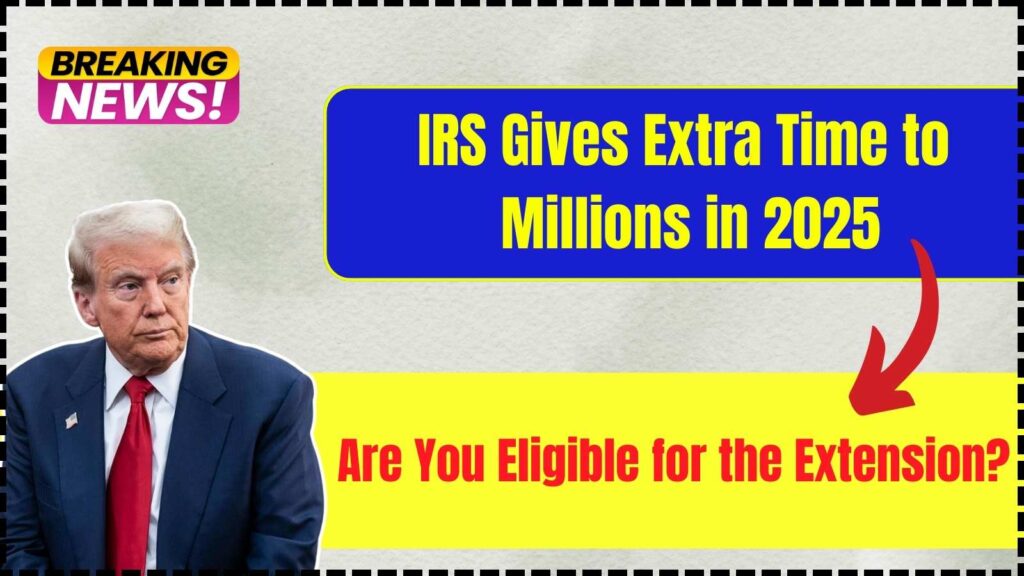IRS Gives Extra Time to Millions in 2025: In 2025, the Internal Revenue Service (IRS) is offering automatic tax deadline extensions to millions of individuals and businesses across the United States. These extensions are part of the federal government’s response to the severe natural disasters that impacted several regions, including hurricanes, wildfires, flooding, and other catastrophic weather events.

If you’re living in or operating a business in one of the federally declared disaster areas, you may qualify for this relief automatically—no paperwork or special requests required. This article breaks down everything you need to know about the extension, including who qualifies, what deadlines have changed, and how to take advantage of the extra time without penalty or added stress.
IRS Gives Extra Time to Millions in 2025
| Topic | Details |
|---|---|
| Relief Type | IRS tax filing and payment deadline extensions |
| Main Reason | Major federally declared disasters in 2024 and early 2025 |
| New Deadlines | May 1, 2025; October 15, 2025; November 3, 2025 |
| Who Qualifies | Residents and businesses in affected disaster zones |
| What’s Covered | Filing federal tax returns, estimated payments, business taxes |
| Do You Need to Apply? | No, relief is automatic for affected areas |
| Additional Benefits | Casualty loss deductions, penalty waivers, refund relief |
| Where to Check | IRS Disaster Relief site for updated areas and criteria |
The 2025 IRS tax extension is more than just a delay—it’s a vital support system for Americans recovering from natural disasters. Whether you’re a homeowner, business owner, or tax professional, knowing how to take advantage of these extensions can save you time, money, and stress.
Understanding the 2025 IRS Disaster Tax Extension
Every year, the IRS steps in to provide relief when natural disasters strike. In 2025, multiple major disasters—including Hurricanes Helene and Milton, wildfires in California, and flooding in Alaska and New Mexico—prompted the IRS to push back tax deadlines for affected regions.
This relief allows people more time to file federal tax returns, make payments, and meet other deadlines, without facing penalties or interest. The extension is designed to reduce stress during recovery and help people and businesses get back on their feet financially.
Who Is Eligible for the IRS Tax Extension?
If you live in a federally declared disaster area, you’re eligible for the tax relief extension—automatically. That includes:
- Individuals living in affected counties or states
- Businesses operating in those areas
- Taxpayers with records stored in affected regions
- Relief workers assisting in those areas, even if they live elsewhere
Even if you live outside a disaster zone but were directly affected (e.g., had a business property damaged or displaced), you can still call the IRS to request relief.
What Are the New Tax Deadlines?
Depending on where you live and the type of disaster that occurred, the IRS has granted different new deadlines for 2025. Here are the most common ones:
May 1, 2025
Applies to most individuals and businesses in regions affected by Hurricanes Helene and Milton and some flood-impacted areas. Includes parts of:
- Alabama
- Florida
- Georgia
- North Carolina
- South Carolina
- Tennessee
- Virginia
- West Virginia
- Alaska
- New Mexico
October 15, 2025
Applies to those affected by the devastating wildfires in Southern California and surrounding regions. This extension offers additional relief to areas that faced prolonged damage and displacement.
November 3, 2025
Applies to residents and businesses in Arkansas and Tennessee that were hit by severe storms and flooding. This is one of the longest extensions offered and includes both filing and payment deadlines.
IRS Gives Extra Time to Millions in 2025 Use the IRS Disaster Relief
You don’t need to feel overwhelmed. Here’s a simple, actionable breakdown of how to take full advantage of the IRS disaster tax relief:
1. Check if You Qualify
The IRS uses FEMA disaster declarations to determine who qualifies. You can check your eligibility by searching for your state or county in the IRS’s disaster relief listings.
2. Gather and Protect Documentation
Make sure to keep copies of:
- Insurance claims
- Photos of damages
- Estimates and invoices for repairs
- Letters or notices from FEMA
These records will be important if you plan to claim casualty losses or need proof for delayed filings.
3. Mark Your Calendar
Use the new deadline that applies to your region. While the relief is automatic, keeping track of your specific due date ensures you don’t miss it.
4. File Electronically if Possible
Filing online is faster, safer, and reduces the chances of errors. Most major tax software tools are updated to reflect disaster extensions.
5. Consider Claiming a Casualty Loss
If you suffered property damage or financial loss, you may be able to deduct it from your taxes. Use IRS Form 4684 to claim uninsured losses on either your current or prior year tax return—whichever benefits you most.
What’s Included in the Relief?
Here’s what the IRS disaster tax extension typically covers:
- Filing individual income tax returns (Form 1040)
- Making quarterly estimated tax payments
- Filing corporate, partnership, or S-corp tax returns
- Contributions to IRAs and HSAs
- Certain business excise tax filings and payments
- Payroll tax reporting deadlines
Important: If you have already filed your return and owe taxes, and you’re in an affected area, you’ll have until your extended deadline to pay without penalties or interest.
Watch Out for Tax Scams
Unfortunately, disaster times also bring out fraudsters. Be cautious of:
- Emails or texts claiming to be from the IRS
- Phone calls requesting personal information or payment
- Websites mimicking official government portals
The IRS never initiates contact via email or phone asking for sensitive details. If in doubt, contact the IRS directly through their official website or customer service line.
Additional Tips for Professionals and Small Businesses
If you’re a tax professional or business owner in an affected area, you may need to:
- Reschedule client deadlines and proactively inform them of changes
- File extensions for payroll and excise taxes
- Apply for penalty abatement if notices are received in error
- Check if you qualify for Employee Retention Credits (ERC) or other special disaster-related deductions
- Businesses with significant losses should also consult a CPA about amended returns or other refund opportunities to help with recovery.
2025 Social Security Boost: 5 Tactics to Reach the Maximum $5,108!
From 62 to 70: The Average Social Security Checks for Each Retirement Age!
Your $1,400 Stimulus Check Awaits: Will You get it? Check Eligibility
FAQs On IRS Gives Extra Time to Millions in 2025
Do I need to file anything to get the extension?
No. If your address is in an IRS-recognized disaster area, the relief is automatic.
What if I moved after the disaster?
If the IRS doesn’t have your updated address, you may not automatically receive relief. Contact them directly to update your information.
Can I still get a refund?
Yes. You can file any time before your new deadline. In fact, filing sooner means you’ll get your refund faster.
What if I already paid penalties or interest?
You can request a refund or penalty abatement by contacting the IRS. Use Form 843 to claim a refund of interest or penalties.








